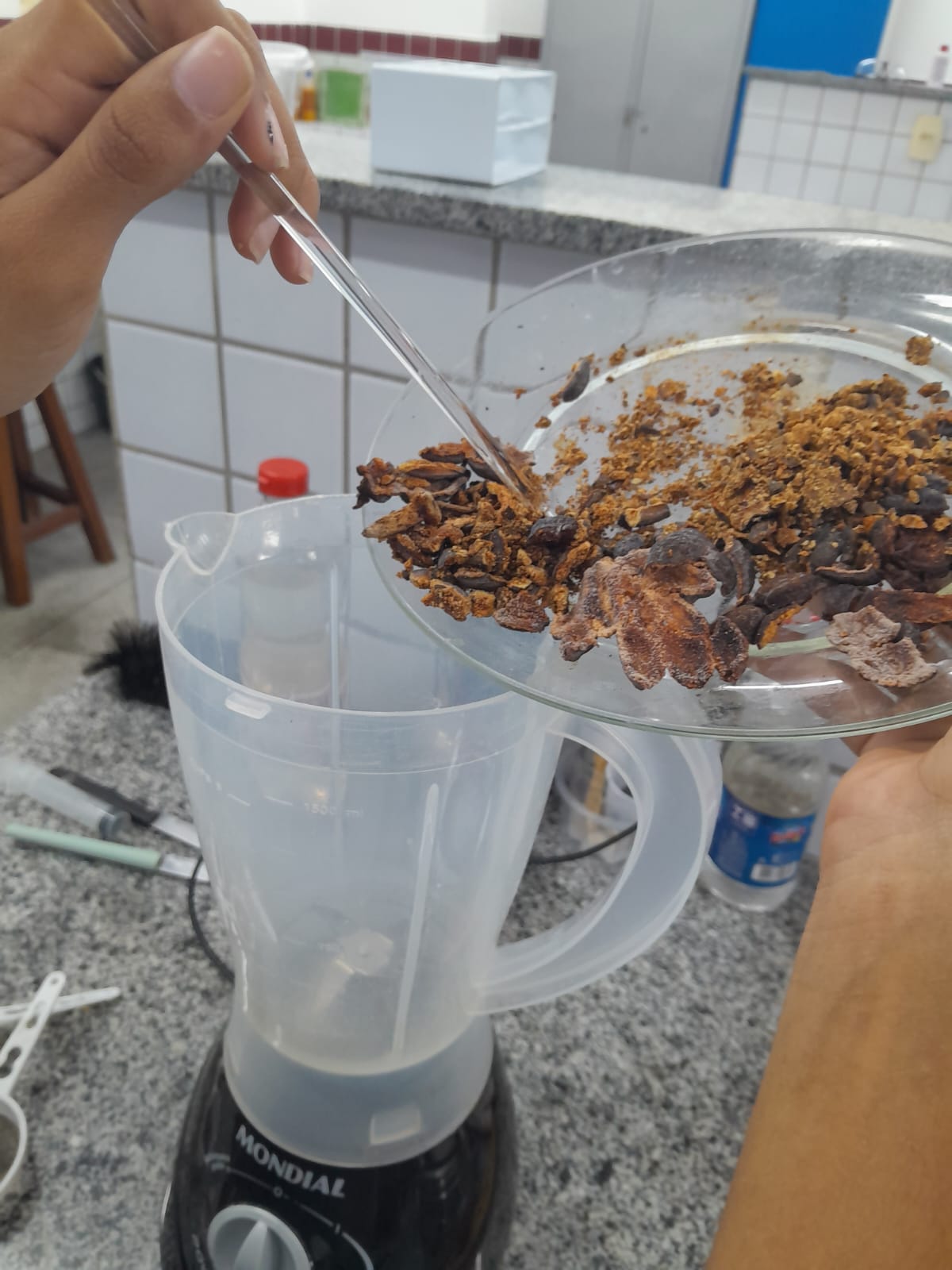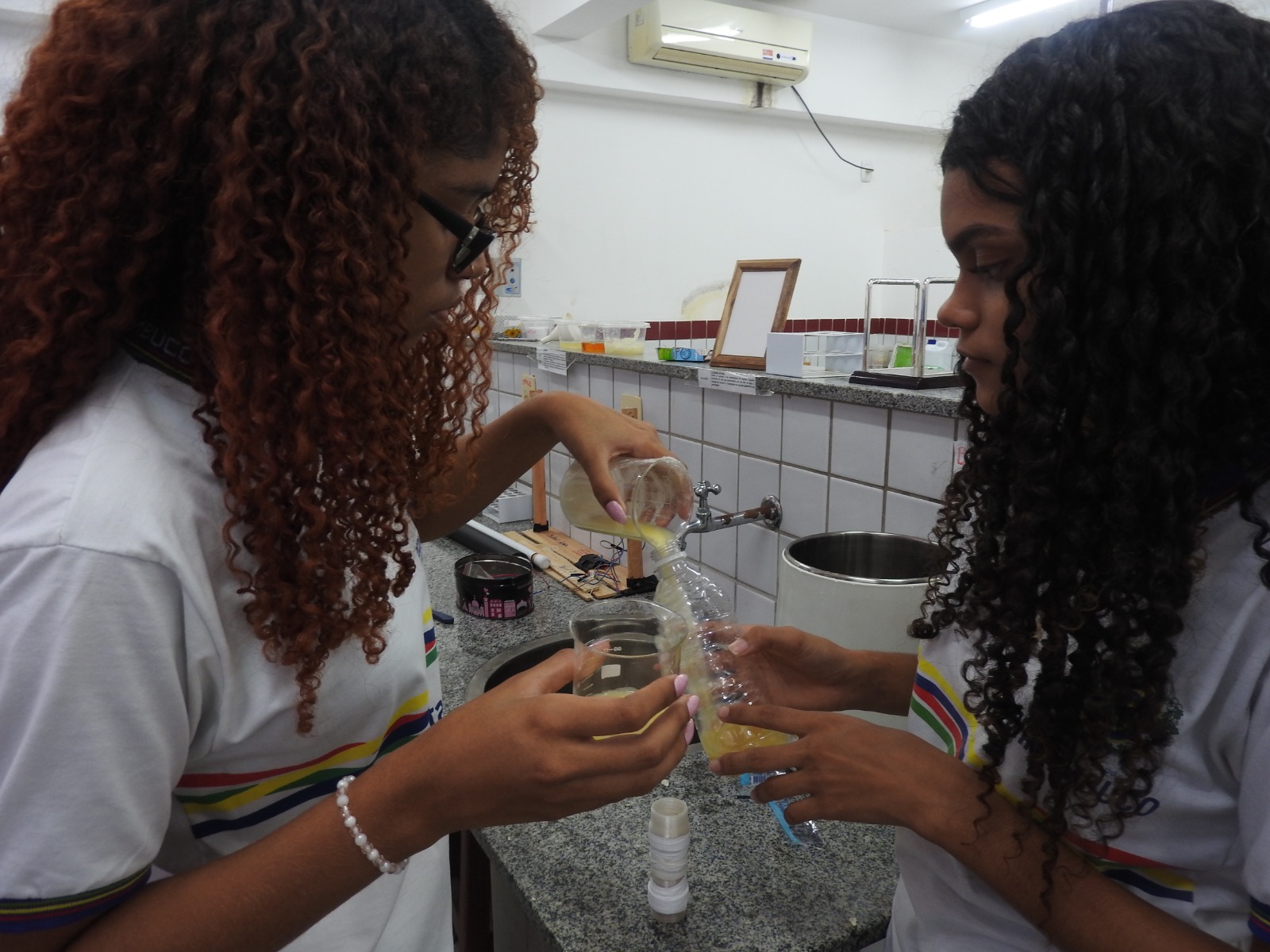Based on their knowledge in STEM (Science, Technology, Engineering, and Mathematics), four teenagers from the countryside of Pernambuco state, Brazil, were inspired to create a project that combines health and environmental benefits. The “Filtropinha” project won the Solve for Tomorrow in Brazil in 2024 and aims to build filters with pine cone shells to treat manipueira, a toxic liquid discarded from cassava flour production.
In the flour mills of Quilombo Travessão do Caroá, in northeastern Brazil, cassava is used to produce a crunchy and tasty flour highly appreciated in the country’s cuisine. Despite being an important source of income for the community, the production of the flour leaves behind a yellowish liquid rich in hydrocyanic acid, an extremely volatile chemical compound.
The group visited the quilombo and flour mills to develop the project. There, they were able to talk to the cassava producers and see the negative effects of improper disposal of it. “We noticed that around the flour mill we visited, there was soil degradation; that nothing grew around where the waste was dumped. And the workers complained a lot about headaches and dizziness,” recalls teacher Bezerra. The students also returned to the quilombola community to show the results of the studies and tests, always using simple language.
If ingested or inhaled, manipueira can lead to death and, if disposed of directly into the environment, can cause soil infertility and water contamination. With this in mind, the students created a prototype of a low-cost filter that reduces the toxicity level of cassava starch by up to 80%, enabling the reuse of water in the production of flour and the manufacture of organic fertilizer with the concentrate that is retained during filtration.
Chemistry teacher Gustavo Bezerra, mediator of the project, says that the idea came from the students themselves, including two young women who live in Travessão do Caroá. “During the Sustainable Construction and Inventions class, some students had already suggested doing a study on these flour mills, which are a source of income for some rural communities here in the municipality of Carnaíba, but these communities have always been neglected,” explains the teacher from the Professor Paulo Freire State Technical School. In addition to him, teacher Carla Robécia was co-mediator of the project that involved four teenagers aged 16 and 17 in the 2nd year of high school (the penultimate year of compulsory education).
We were in the last week of mentoring the project without achieving satisfactory results. We filtered the manipueira, and the liquid became even more acidic. Until we added activated carbon, and everything started to work. The liquid became clearer, the conductivity and pH reduced and the toxicity test further confirmed the improvement, says Gustavo Bezerra.
Practical tests led to a prototype
Before getting the filter to work, the team tried out different methods. One of the first ideas for reducing the acidity of manipueira was decantation, a method of separating heterogeneous mixtures between solid-liquid and liquid-liquid. They also thought about installing a membrane to reduce the acidity of the manipueira, but the problem persisted. After consulting bibliographical references and deciding on the use of activated cardboard, they set out to build a filter on a 3D printer that could be attached to a box containing the manipueira. Inside, the filter was filled with a layer of cotton, a paper filter, pine cone shell flour, and activated carbon made from the same shell. Without considering labor, each complete prototype costs around R$4.41 (about 0,80 USD), and the refill alone costs around R$0.25 (about 0,05 USD).
To ensure effective results, the toxicity of manipueira was tested before and after filtration. To do this, the students used a low-cost methodology with lettuce seeds. They were exposed to the liquid before and after passing through the filter and then planted. Before the addition of activated carbon to the prototype, only 20% of the seeds germinated. Afterward, 80% of the planted seeds developed.
The numerical scale used to specify the acidity or basicity of a solution is the pH. After filtration, this scale was measured, and the indicators also showed an improvement in the toxicity of manipueira. According to tests carried out in the school’s laboratory, after filtration, the liquid reached close to pH 7, considered neutral, which shows a significant loss of acidity in the sample.
The next steps are to improve the prototype so that it can be attached to water tanks to filter large volumes of manipueira. Another goal of the project is to use the pine cone shells and activated carbon after filtering as a slow-release fertilizer since the material becomes rich in nitrogen and carbon.
“The idea now is to try to secure financial support from the city government to buy some additional materials to carry out these tests. For example, we want to provide the filter to three flour mills, and after the treatment, we also want to test the fertilizers to contribute even more to the community,” highlights Gustavo Bezerra.
Students consulted bibliographical references and tried out various hands-on methods until they arrived at the prototype.
SDGs guided STEM project
The use of STEM projects that focus on the Sustainable Development Goals (SDGs) has been an important tool for engaging students in practical learning, complementing the theoretical class. Teacher Gustavo Bezerra, who has participated in Solve for Tomorrow on other occasions with projects developed at ETE Professor Paulo Freire, highlights the importance of this approach to improving the lives of those who apply the knowledge. “If at school they learn about water treatment using an electroflocculation process, it is not only at school that this electroflocculation can be done. It is something that can improve their quality of life in the community,” the teacher explains.
In “Filtropinha”, teacher Bezerra reports that the students gained more confidence and ease in speaking in public after Solve for Tomorrow. Above all, they learned not to give up on the project at the first failure. “These kids are very curious; they have access to a lot of information, and in their community, they can observe a lot. We, as teachers, must guide them towards this path, which is the choice of what they want to do in their academic life. Working with ‘Filtropinha’ in Solve for Tomorrow was rewarding. We, as teachers, are adapting so that our pedagogical practices do not become rusty. This makes us evolve”, concludes Bezerra.







